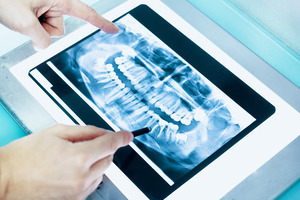
It’s probably no surprise to learn that before you can begin the orthodontic process, your orthodontist will need to capture X-rays of your teeth and jawbone. Furthermore, additional X-rays will need to be taken throughout the treatment in order to confirm that everything is proceeding as planned.
However, some patients are worried about the radiation involved with having their X-rays taken – but is this truly something you need to be concerned about? Here’s what you need to know before scheduling a consultation.
How Do Dental X-Rays Work?
Taking X-rays involves a narrow beam of specialized photons used to capture images of your mouth. The photons pass right through your body’s softer tissues, but some of them are absorbed by the calcium in your teeth and bones. The areas that absorb photons will appear sharp white in the final image, thus allowing your orthodontist to examine the key structures that will be involved with your treatment.
How Much Radiation Do Dental X-Rays Expose You To?
First of all, it’s important to realize you’re exposed to radiation more often than you might think. It’s estimated that the average American receives about 620 millirems of radiation in a single year, and much of that comes from radon in the air. Other everyday sources of radiation include microwave ovens and smoke detectors.
With all that in mind, the amount of radiation involved with dental X-rays is actually very small. You can expect to receive around 0.5 millirems of radiation from traditional radiography. Digital X-rays emit even less – roughly 0.1 mrem in many cases.
In short, there’s very little reason to worry about radiation exposure when your orthodontist tells you that X-rays are necessary.
What Kinds of X-Rays Do Orthodontists Take?
When planning your treatment, your orthodontist will likely take what is known as a panoramic X-ray. This results in a full two-dimensional image of all of your teeth as well as your upper and lower jaws. Panoramic X-rays capture more detail than regular X-rays and can give your dentist valuable insight into the positioning of your teeth as well as any abnormalities in your jawbone.
A cephalometric X-ray may also be necessary. It can be used to capture the entire side of your head, which lets your orthodontist get a good look at the relationship between the teeth and the jaws.
If you’re planning on scheduling a consultation with your orthodontist in the future, feel free to ask about the kinds of X-rays they might need to take and why they might be necessary.
About the Author
Dr. Jessica Cohen earned her Certificate of Orthodontics from the University of Illinois at Chicago. She has done extensive research in order to provide orthodontic treatments that improve both the function and appearance of the smile. Her Highland Park practice offers X-rays and other examples of modern orthodontic technology. To schedule a consultation with Dr. Cohen, visit her website or call (224) 427-6800.
